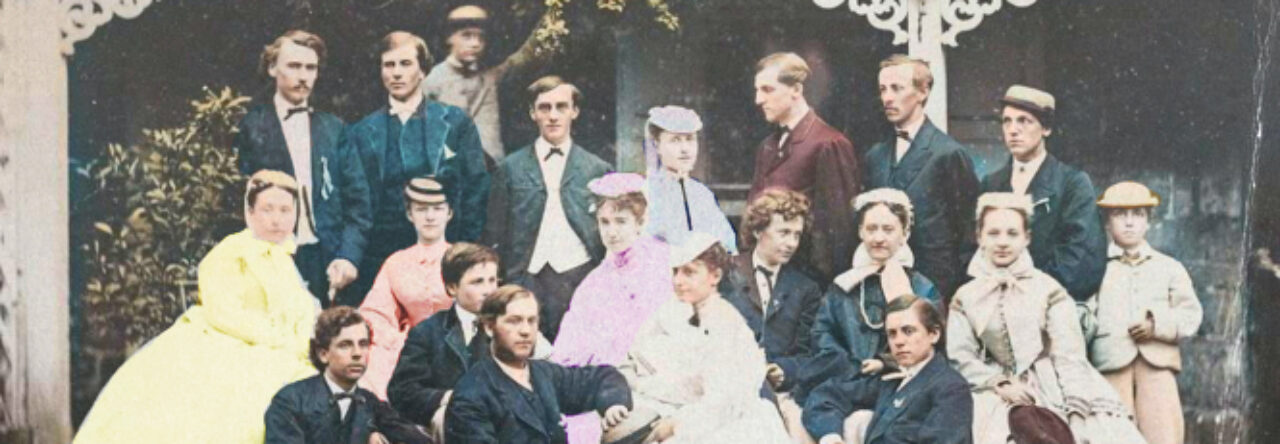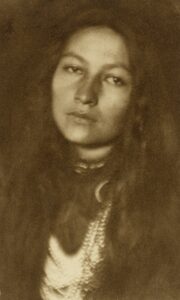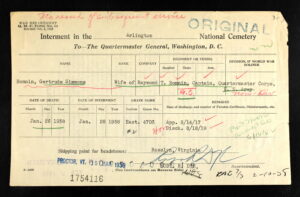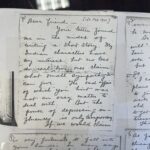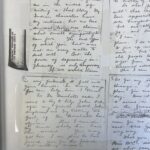To begin my search for sources on Gertrude Bonnin/Zitkala-Ša, a Yankton Sioux woman who had taught at the Carlisle Indian Industrial School, I decided to go to the Dickinson College Archives and speak with the people I figured would know the most about her—my bosses, Malinda Triller-Doran and Jim Gerencser.
As a student archival assistant, I spend lots of time in the archives with our resident archivists, so I decided to take advantage of that. I asked Malinda if she knew who Gertrude Bonnin was. I mentioned that she had been a teacher at the Carlisle Indian School, but she did not recognize the name. “Jim will definitely know about her,” Malinda told me.
When I asked Jim if he knew who she was, and whether there was any information on her in the archives, he knew exactly who I was talking about, but told me that I was unlikely to find much on her in the College Archives. He told me that Bonnin, who also shows up on records as Gertrude Simmons or as Zitkala-Ša, was only a teacher at the Carlisle Indian Industrial School for about eighteen months, so the Carlisle-related documents were scarce. None of these documents were available for viewing in the college archives, but those that did mention Bonnin could be found online through the Carlisle Indian School Digital Resource Center.
After my shift ended, I entered Bonnin’s name into the search bar of the Digital Resource Center’s website. Nothing came up, so I tried her tribal name, Zitkala-Ša, and got multiple hits. Just by looking at the first document that came up, a report on Carlisle Indian School teachers from 1897, I saw that Bonnin was still unmarried while she was at Carlisle and therefore came up under Simmons, her anglicized maiden name. I now knew the right name to use in searches if I wanted to find anything relating her to the Carlisle Indian Industrial School.
As I continued to sift through the documents that mentioned her name, I found two that allowed me to piece together her time at Dickinson. The “Oaths of Office” documents from July 1897 contain the Oaths of Office of numerous teachers who were new to the school, including Gertrude Simmons. Her Oath was dated July 10th, 1897, officially marking her time at the Carlisle Indian Industrial School. Simmons’ time at the school soon came to an end, however. After seventeen months of teaching music, Simmons’ resignation was announced by Pratt in a telegram to the Office of Indian Affairs where he requested a replacement. The telegram is dated December 12th, 1898.
Gertrude Simmons went on to the New England Conservatory for Music to continue her studies while also publishing short stories and essays in publications like The Atlantic Monthly, which she had begun to do while teaching in Carlisle. I was told previously by Jim Gerencser that this time of her life, the post-Carlisle era, was truly the start of her incredibly prolific career as an artist, in more ways than one. Naturally, I wanted to find out about her own work and the life she led once she moved on from the school.
I went down to the Cumberland County Historical Society to see what they had. I was hopeful they might have some of her writings, but my primary goal was to look at Newspapers.com and find articles about her and her career. I searched specifically for hits on Bonnin in the period after she left Carlisle, setting the limitations to 1899-1910. She was often written about in regards to her musical talent (she was a composer and played the violin), but occasionally for her writing as well. The most interesting bit of information I found was in an article about her titled “A Bright Sioux Maiden,” from Lyon County Monitor. It included a sketched image of her, and ended with this: “She will go to the Paris exposition with the Carlisle Indian Band.”
Because the article was dated from 1900, I assumed this meant she would be performing at the 1900 Paris Exposition, an international fanfare, and I was immediately impressed. I had no idea that she had performed at such an event, never mind the fact that she was there with a band from Carlisle. This was a clear indicator of just how talented a musician Bonnin was. A quick look at her Wikipedia page seemed to confirm this information, and I knew that I was just scratching the surface of Gertrude’s life.
While at CCHS, I also looked up Bonnin up on Ancestry. I discovered that she married her husband, Raymond Bonnin, in 1902 and managed to locate an article announcing their marriage. Furthermore, her burial information was made available to me—Gertrude Simmons Bonnin is buried in Arlington National Cemetery. Her husband’s status as a veteran of WWI qualified her to be buried there despite the fact that she predeceased him, and she was interred there just two days after her passing in January 1938.
I was pleased with what I had found, but I hadn’t even searched in the CCHS catalog for relevant materials, so that was what I did next. There were pages and pages of results, and I knew I would never be able to read them all, so I tried to focus on anything that looked like Bonnin’s own writing. I made sure to search for sources under her tribal name Zitkala-Ša because that is how she was commonly known publicly, especially as a writer. Eventually I found what looked like correspondence between her and various people amongst some other interesting items, so I asked the archivist to pull those items for me. Her correspondence ended up being in a long black binder. The first few letters were handwritten, clearly copies of originals, and split onto multiple little pieces of paper taped onto a sheet in the binder. Many of them were addressed to an unnamed person—only “Dear friend” was written. I also noted that they were sometimes signed as Zitkala-Ša and other times as Gertrude Simmons (she was not yet married—these letters were from 1901), so she seemed to use the two interchangeably in her personal life.
The first one begins like this:
“Dear friend —
Your letter found me in the midst of writing a short story. My Indian characters have my interest but no less do real live ones claim what small sympathy I can give.”
Some words are harder to read, but it seems that her friend had written her with bad news, or retelling something troubling (she referred to a “sad affair”) and so she responded accordingly. It was also fascinating to see her speaking of her own work and writing process. This was the time in her life where she wrote many pieces for The Atlantic Monthly, so it was reasonable to infer that whatever she had been writing when she received the letter from her friend may have ended up in a 1901 issue from that publication.
- First page of a letter written by Bonnin
- Organization of Bonnin’s correspondence in the CCHS Archives
Bibliography
Ancestry.com. U.S., National Cemetery Interment Control Forms, 1928-1962 [database on-line]. Lehi, UT, USA: Ancestry.com Operations, Inc., 2012.
“A Bright Sioux Maiden.” Lyon County Monitor, June 15, 1900. Newspapers.com, [WEB].
Britannica Academic, s.v. “Zitkala-Sa,” accessed March 30, 2023, [WEB].
Kort, Carol. “Zitkala-Sa.” In A to Z of Women: American Women Writers, by Carol Kort. 3rd ed. Facts On File, 2016. [WEB].
“Oaths of Office, July 1897.” Carlisle Indian School Digital Resource Center. Archives & Special Collections: Waidner-Spahr Library, Dickinson College. [WEB].
“Report on Teachers at the Carlisle Indian School in 1897.” Carlisle Indian School Digital Resource Center. Archives & Special Collections: Waidner-Spahr Library, Dickinson College. [WEB].
“Resignation of Gertrude Simmons and Request for Replacement.” Carlisle Indian School Digital Resource Center. Archives & Special Collections: Waidner-Spahr Library, Dickinson College. [WEB].
Zitkala-Ša, Letters (in binder). 1901. Cumberland County Historical Society, Carlisle, PA.
“Zitkala-Sa.” Wikipedia, 11 Sept. 2021, [WEB].
